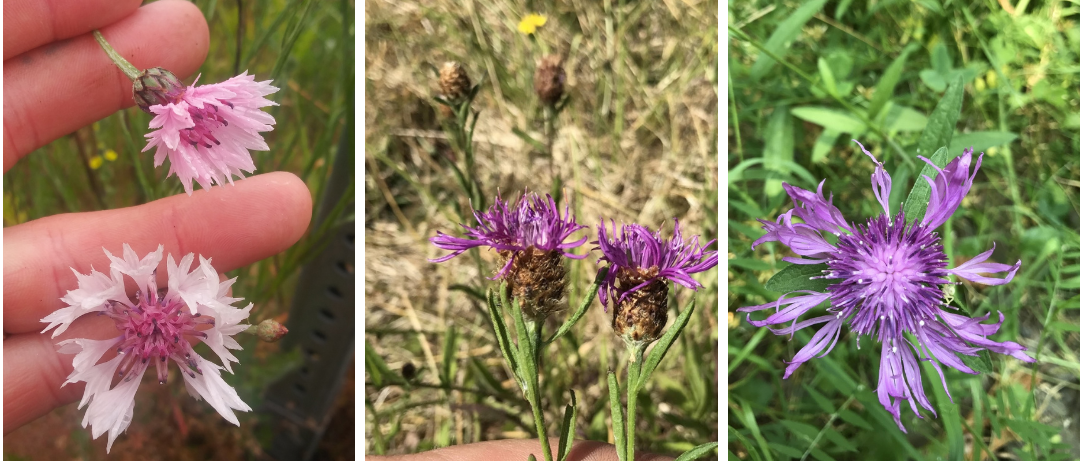
Not Your Granny’s Garden: Tale of the Pretty Weeds
June 2021
While my Granny loved the bachelor buttons (Centaurea cyanus) she had in her flower bed, I get a sense of foreboding seeing just one rosette or flowering stalk at a project site. This really shows how ‘weeds’ are simply plants growing in undesired locations, and that no plan is inherently bad. My mom frequently expressed fond memories of her grandma’s beloved flower patch, which has a deep loving connection for her. My main association with bachelor button, on the other hand, is of an obnoxious plant that overwhelms the grasslands we are diligently working to restore. This doesn’t stop me, however, from taking a moment to appreciate the complexity of its corolla shape and the goofy fringe tipped phyllaries surrounding the inflorescence. I find knapweed species (Centaurea sp.) like bachelor button to be very striking in appearance and I frequently admire them…before ripping them out of the ground, cutting the flower heads off to reduce the amount of dropped seed or spraying with herbicide to reduce foliar competition with nearby native plants. In uncommon ecotypes, like meadows, the destructive potential of weeds like bachelor button and the need to remove them far outweighs my desire to get a close look at the inflorescences.
It is possible to admire the beauty, complexity or fortitude of a plant’s survival strategy and also recognize the harm it can do on a landscape and the need for its removal. This feeling doesn’t stop with knapweeds, either. I am quite fond of thistles, for instance! I never would have noticed the wonderful native thistles such as short-styled thistle (Cirsium brevistylum) and edible thistle (Cirsium edule) if I hadn’t started admiring the average bull thistle flower. There are a few different thistle types worth noting, like the plumeless thistles (Carduus sp.) or the plumed thistles (Cirsium sp.), with feathery branching pappus or the white latex exuding, and yellow-flowered sow thistle (Sonchus sp.). I find them all worth the time to inspect and get to know! Even with my admiration of the floral parts, though, I still kill all the non-native Canada, Italian and bull thistles I come across in order to maintain habitat for the native plants with less aggressive survival tactics. Admiration and eradication can go hand in hand. There are many more examples of pretty weeds in our midst that are worthy of a quick close look before or after you uproot the plant. IAE has a helpful pocket-sized book titled “Field Guide to Weeds of the Willamette Valley” that can be purchased for a nominal fee from our website.
Please, take time to admire some beautiful weeds around your favorite hiking spot, then do us all a favor and pull them before they set seed and reproduce. These plants can actively do harm to many native species, including pollinators and rare or endangered plants and their habitats. Enjoy your favorite natural areas and pull a couple weeds (even if you find their flowers attractive) on every trip you take to keep the area looking nice. Meadows, prairies and trails are not your granny’s garden!
Restoration
Research
Education
Get Involved
Contact
Main Office:
4950 SW Hout Street
Corvallis, OR 97333-9598
541-753-3099
info@appliedeco.org
Southwest Office:
1202 Parkway Dr. Suite B
Santa Fe, NM 87507
(505) 490-4910
swprogram@appliedeco.org
© 2025 Institute for Applied Ecology | Privacy Policy


